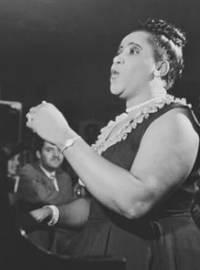
In the late 19th century, New Orleans became the epicenter of the emergence of jazz, as played by pioneering artists like Charles “Buddy” Bolden. Jazz can be defined as a multi-cultural blend of African and African-American aesthetics with European musical concepts. African traits in jazz include syncopation; spontaneously improvised lyrics and instrumental solos; the human voice as an instrument, without lyrics; call-and-response between band leaders and their accompanists; the use of bent, slurred, or deliberately dissonant notes, and the lack of boundaries between performers and audiences, so that some audience participation is accepted.
These African attributes were far more prevalent in New Orleans than in other southern cities, because Louisiana had been a French colony. In British colonies in America, slaves were strictly banned from assembling in public to celebrate their African heritage. But in New Orleans, where the French ruling class lived in fear of slave rebellions, cultural expression was allowed as a safety valve for tensions that otherwise might lead to a revolt. This was an act of self-preservation rather than one of kindness. As a result, slaves were permitted to gather on Sundays in Congo Square (the present site of the Municipal Auditorium) to participate in African-rooted dancing, singing and drumming.
After the Civil War, these musical traditions lived on in the city’s Black community, where they strongly influenced the new genre of jazz. Jazz also drew on many aspects of European/Western music, in terms of standardized musical notation and song forms, as well as the instruments on which jazz was played, especially brass and woodwinds. In addition, musicians from New Orleans’ Latin American and Italian communities contributed to this emerging art form.
Major figures in the early evolution of New Orleans jazz include trumpeter and cornetist Louis Armstrong, trombonist Kid Ory, clarinetist and soprano saxophonist Sidney Bechet and pianist and composer Jelly Roll Morton. They all ventured forth from New Orleans to bring jazz to audiences around the globe. A century later their legacy lives on in the work of such contemporary traditionalists as clarinetist Dr. Michael White and trumpeter and cornetist Gregg Stafford. The rich tradition of parading brass bands has been revitalized by such groups as the Dirty Dozen, the Pinettes, ReBirth, and the Soul Rebels.
Louisiana jazz musicians have excelled in numerous modern styles — such as swing and bebop — that do not have uniquely local roots. World-renowned, their numbers include the avant-garde saxophonist and educator Edward “Kidd” Jordan; drummers Herlin Riley and Johnny Vidacovich; scat singer Germaine Bazzle; trumpeter Wynton Marsalis; pianists Ellis Marsalis and David Torkanowski; bassist James Singleton; saxophonists Wessell “Warmdaddy” Anderson, Tony Dagradi and Donald Harrison, and guitarist Steve Masakowski, among others. Their collective legacy is in the good hands of such acclaimed young players as pianist Oscar Rossignoli, drummer Julian Addison, trombonist Stephen Walker and saxophonist Trevarri Huff-Boone.
Authored by Ben Sandmel








